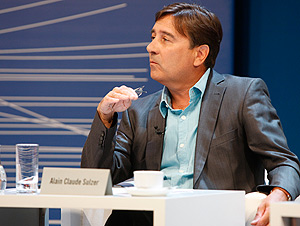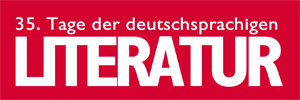 Maximilian Steinbeis (Bild: Johannes Puch)
Maximilian Steinbeis (Bild: Johannes Puch)
Maximilian Steinbeis (G) Jury discussion
Maximilian Steinbeis (G) read a self-contained text entitled "A treasure buried". The jury was in part pleased and in part unimpressed.
 Maximilian Steinbeis (Bild: Johannes Puch)
Maximilian Steinbeis (Bild: Johannes Puch)
Video portrait
Reading
Discussion
Sulzer: "Text with a punchline"
"This text hinges on an anecdote with a punchline" Alain Claude Sulzer said - which was "hilarious" when first read but at the second reading not quite as funny. The problem with this "funny story": there is not really a person talking.
 Alain Claude Sulzer (Bild: Johannes Puch)
Alain Claude Sulzer (Bild: Johannes Puch)
Jandl: "I didn't find it funny"
"You may accuse me of being humourless but I didn't find it funny" added Paul Jandl. You just have to deal with a service provider, Jandl answering the question left open by Sulzer. The text, however, possesses "neither wit nor humor" - and would need to be worked more accurately - so it "asserts" simply one thing after another.
 Publikum (Bild: Johannes Puch)
Publikum (Bild: Johannes Puch)
Winkels: rather unimpressed
"A not great, but very self-contained text," said a rather unimpressed judge Hubert Winkels The text carried its purpose through - the implementation was consistent, the objectives of the text were however quite limited.
Keller: "Hyper-realistic satire"
"The theme is gripping," said Hildegard E. Keller of the text, which in her view showed something of a hyper- realistic satire. The question remained open: who is it who is speaking? Overall, the text wasn't target-oriented enough, it was "too playful", to be able to distinguish an inner voice.
 Burkhard Spinnen (Bild: Johannes Puch)
Burkhard Spinnen (Bild: Johannes Puch)
Strigl: "Parody of a literary guide"
Strigl: "Parody of a literary guide"
Daniela Strigl declared the "very extroverted" text as a parody of eitquette guides. It pretends to give guidance on a return to good old values, but this proves no longer possible without devaluing humanity, as is shown by the murder at the end. The metaphysics is altogether removed, the only remains left by the characters being a corpse and a gold nugget , which could be later dug up by the grandchildren.
"There is not a superfluous phrase in it", according to Strigl, Steinbeis' text is a satire on "our naive trust". " I liked it" said the juror.
Feßmann "impressed"
Meike Feßmann was also quite impressed: particularly at first reading the text is still "silly", but by the second reading the "pitfalls along the way" are rather more significant. The punchline which the text leads up to is not exhausted on second reading, on the contrary.
Spinnen: "no callousness"
"Yes, you can accuse the text of anything, but not callousness" disagreed Spinnen. The person talking to us here is Mephistopheles himself - and one could hardly accuse him of the absence of powerful emotions. Steinbeis' text answers the great question of the present, the fear that "the entire business of paper money can come to an end".
"It hangs like a Damocles sword over us," Spinnen said, pointing to to the situation in Greece "This is a very simple design that dates back to the fairy tale, because the text takes many liberties. "He is looking for simple solutions, but the implications could be seen as "devilish". "Superbly" done, said Spinnen.
Jandl: "Simply achieved"
Paul Jandl then tried again to deconstruct the "metaphysically complex" text: this is still in reality very "simply" done, it was not the "little man" who buried the gold here, it was "capital" itself.
Barbara Johanna Frank
 TDDL 2011
TDDL 2011